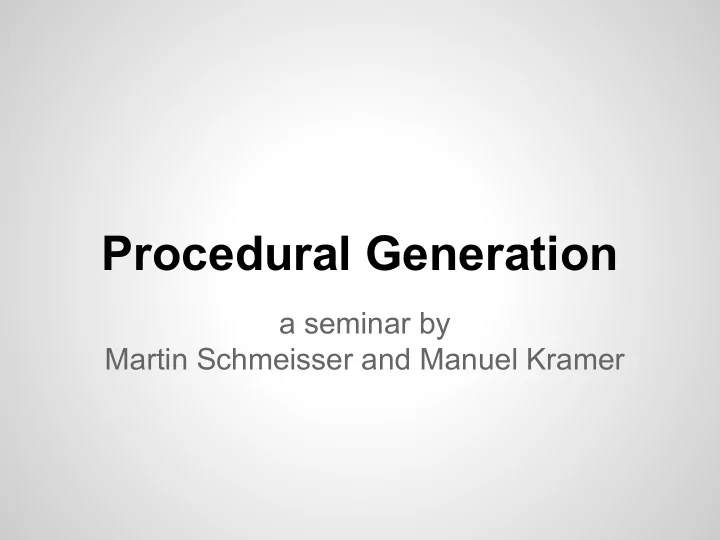

Procedural Generation a seminar by Martin Schmeisser and Manuel Kramer
What Is Procedural Generation? Creating content based on algorithms instead of manually doing it.
Small Introduction
What can procedural generation be used for? - Video Games - 3D Renders - Simulations
Examples of procedural generation - Textures - Terrains World/Terrain Voxel based Grid based Tile based - Animations - Single Object Generation - Trees - Weapons - Life forms
Which Games use procedural generation? - Minecraft - Diablo - Binding of Isaac (Rebirth) - Borderlands - Black Mesa ( Half-Life fan remake ) - and almost every rogue like...
Textures
Perlin Noise - Type of Gradient noise - Commonly used as procedural texture in computer graphics - Easy to control the paramaters - Vast variety of different outcomes
Perlin Noise - Pros for perlin noise: - Fast in generating - Easy to control - Cons for perlin noise - Tends to create same patterns all over again
Examples of Perlin Noise
Example Of Procedural Terrain Texturing [ Live Demo ]
World And Terrain Generation There are three commonly used ways of generating worlds. - Grid based terrains
Grid Based Terrains - Using a plane in 3D space to generate a terrain - Each vertex gets a height assigned - Height is calculated with perlin noise - Texturing is done with procedural texturing
World And Terrain Generation There are three commonly used ways of generating worlds. - Grid based terrains - Voxel based worlds
Voxel Based Worlds - Created with voxels - Point in 3D environment grid - Mostly represented with cubes - Split up into “Chunks” - X * X * Y areas - Can it be infinite? - yes and no at the same time - limited space for saving chunks - overwriting chunks when it gets too big
Voxel Based Worlds - How to generate the actual world? - Using 3D perlin noise - everything < 0 is air - everything >= 0 is ground - The right resolution is crucial - Too high of a resolution can cause: - Performance issues - Floating “boxes” - Split the world into the chunks - e.g. use one noise map per chunk - e.g. split one noise map into mulitple chunks
World And Terrain Generation There are three commonly used ways of generating worlds. - Grid based terrains - Voxel based worlds - Tile based worlds
Tile Based Worlds - Based on predefined tiles that can make up the landscape - Walls, Forest, Houses etc. - Tile information, which tiles fit together? - Different wall parts, grass, sky - Where is a passage? - Created with recursive algorithm - Each tile spawns new tiles for their openings - Each tile checks if a tile can be placed - Internal integer can define if the world is big enough
Tile Based worlds But is it that simple? No there needs to be a lot taken care of! - Just checking for a point to attach new tile to is not enough - Checking the area for other parts - e.g. there is a gap between two tiles → find a tile which fits for both ends. - Make sure that it has an end - don’t let it generate forever!
World Generation In General - Has to be fast - Should not take to much processing power - Combination of random and crafted - Create random worlds with a charm to explore - Hard to prevent glitches
Single Object Generation - Pick an Object - Houses, Trees, Rocks, Weapons - Define those Object - How does the Object look like - Limit the range of the parameters - Describe the textures that can be used - Predefine parts - One way to achieve the generation is to create different parts that match together ( similiar to tiles )
Example For Object Generation (Borderlands)
Single Object Generation
Animations - Animation based on the Terrain and the possibilities of the Character - Dynamical moving instead of predifined - walking up and down stairs/slopes - climbing - Many games use a simple variant of procedural animation - Even turning a characters head to a specific point is procedural animated
Animations - Even particles are procedural animations - Fire - Cloth, - Fur - Water can be generated this way as well - Morrorwind used that technology - Raimonds water simulation is part of this as well
Animations
Life Forms - A bit like object generation - predifined races and rough looks - different body parts - textures that match the races body parts - A rigged body - for every body part there needs to be a rig that already works - generated on the fly
Example Of The Use Of Life Forms - Starbound (Game) - Creating unique monsters the player has to encounter - Black Mesa (Game / Halfe-Life remake) - Zombie and character parts are provided and used to create unique characters - No Man’s Sky (Game) - Create every life form from scratch on run time
Examples Of Life Forms (Starbound)
A Look Into The Future
Recommend
More recommend